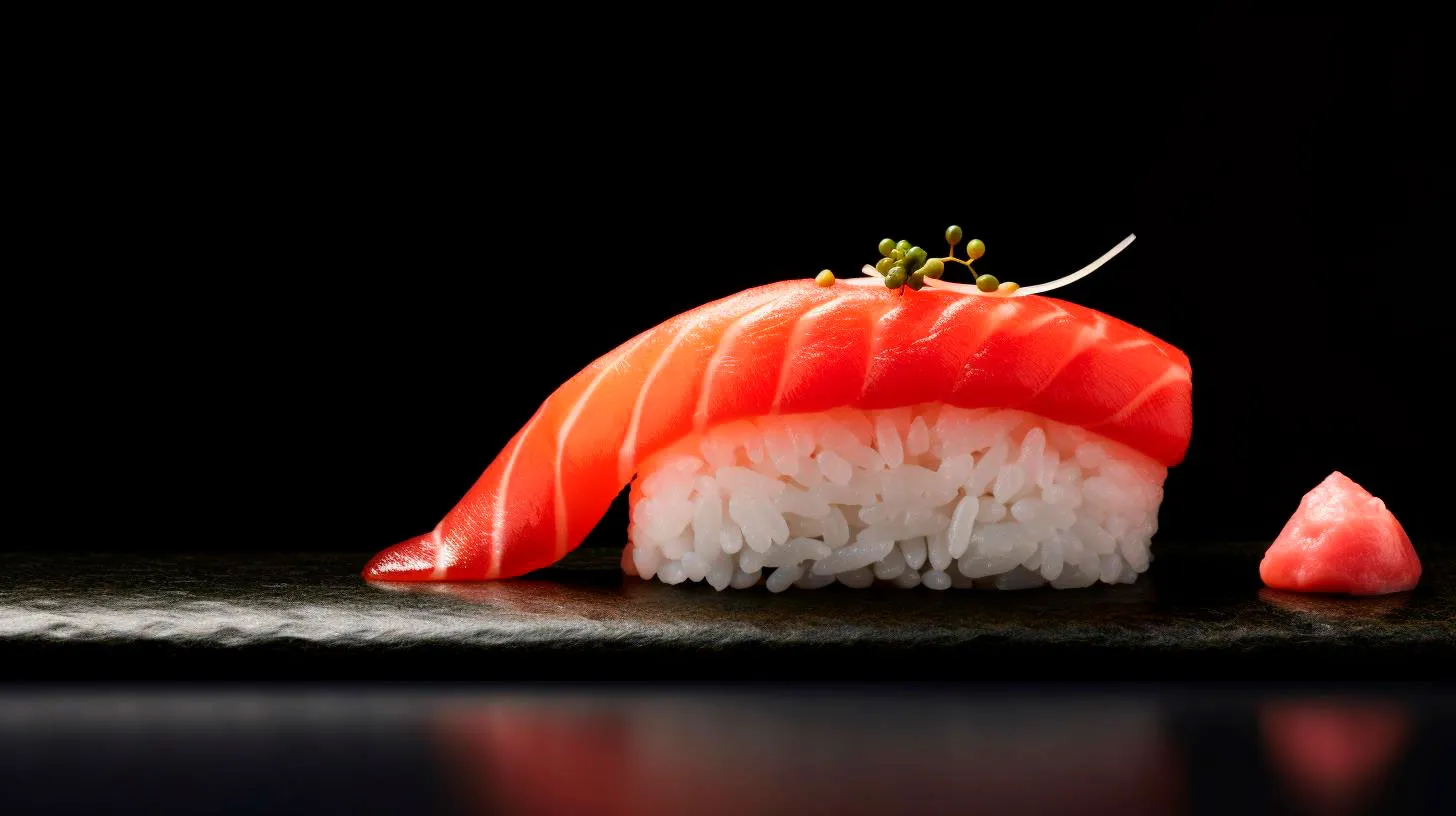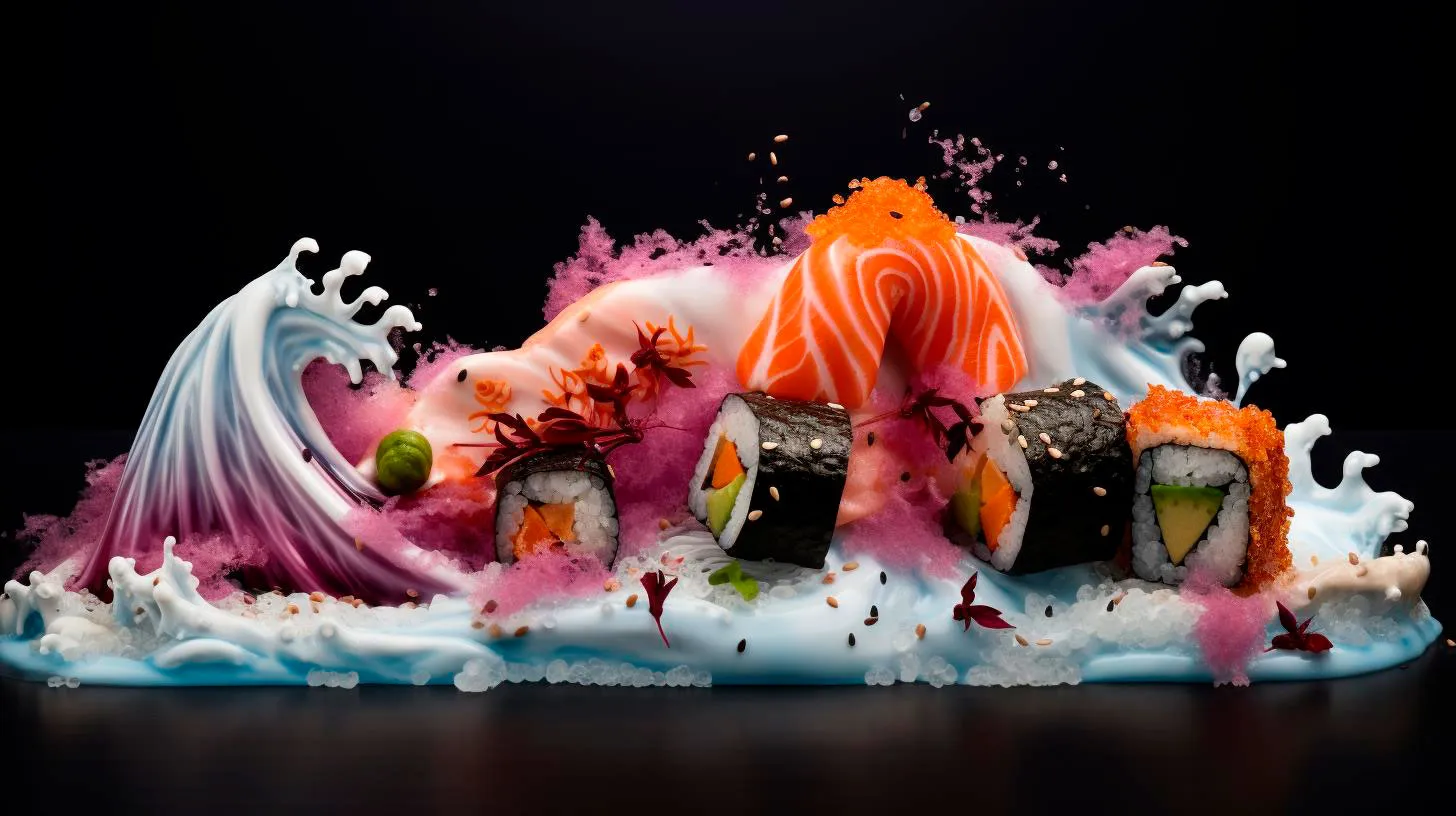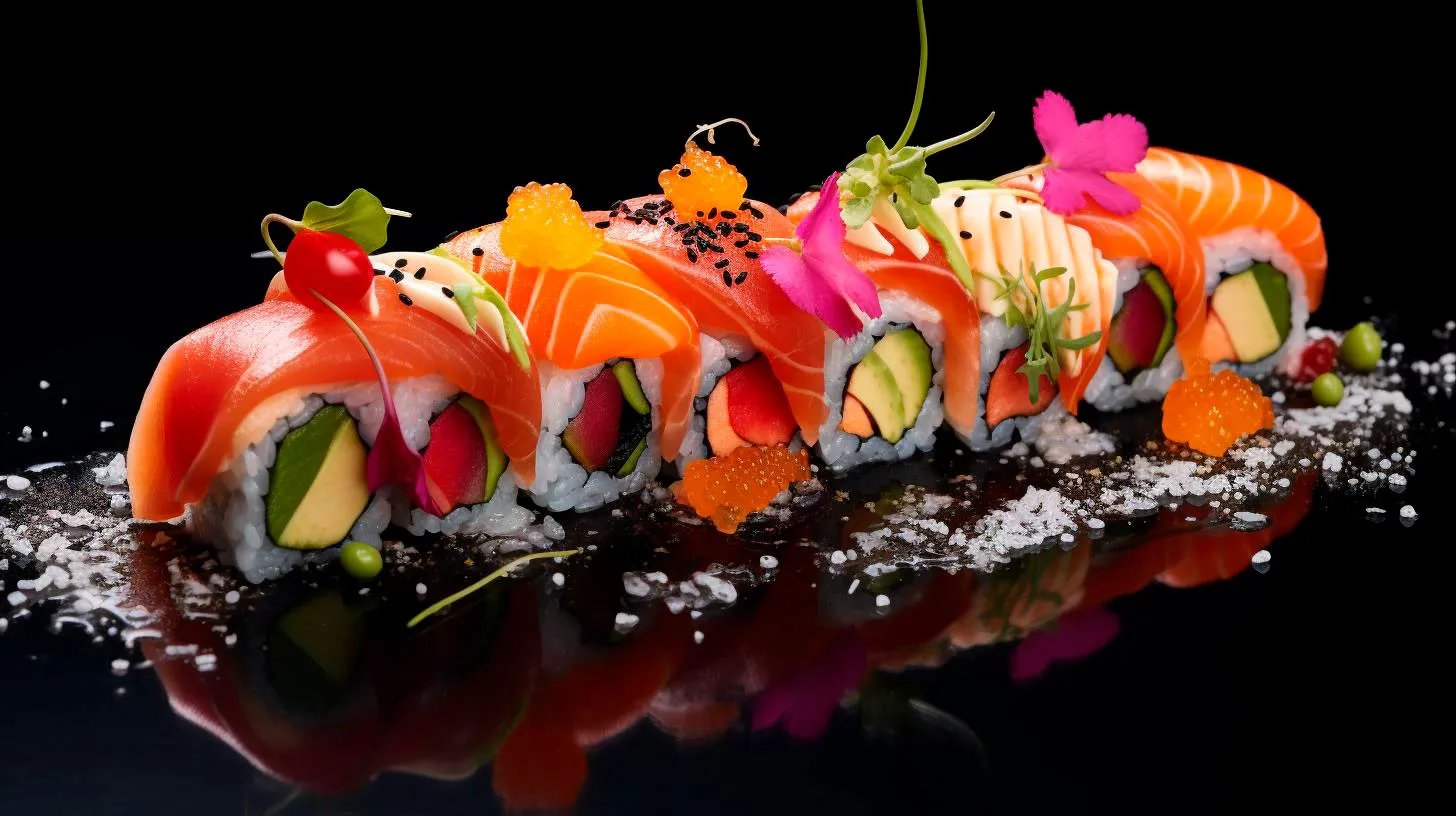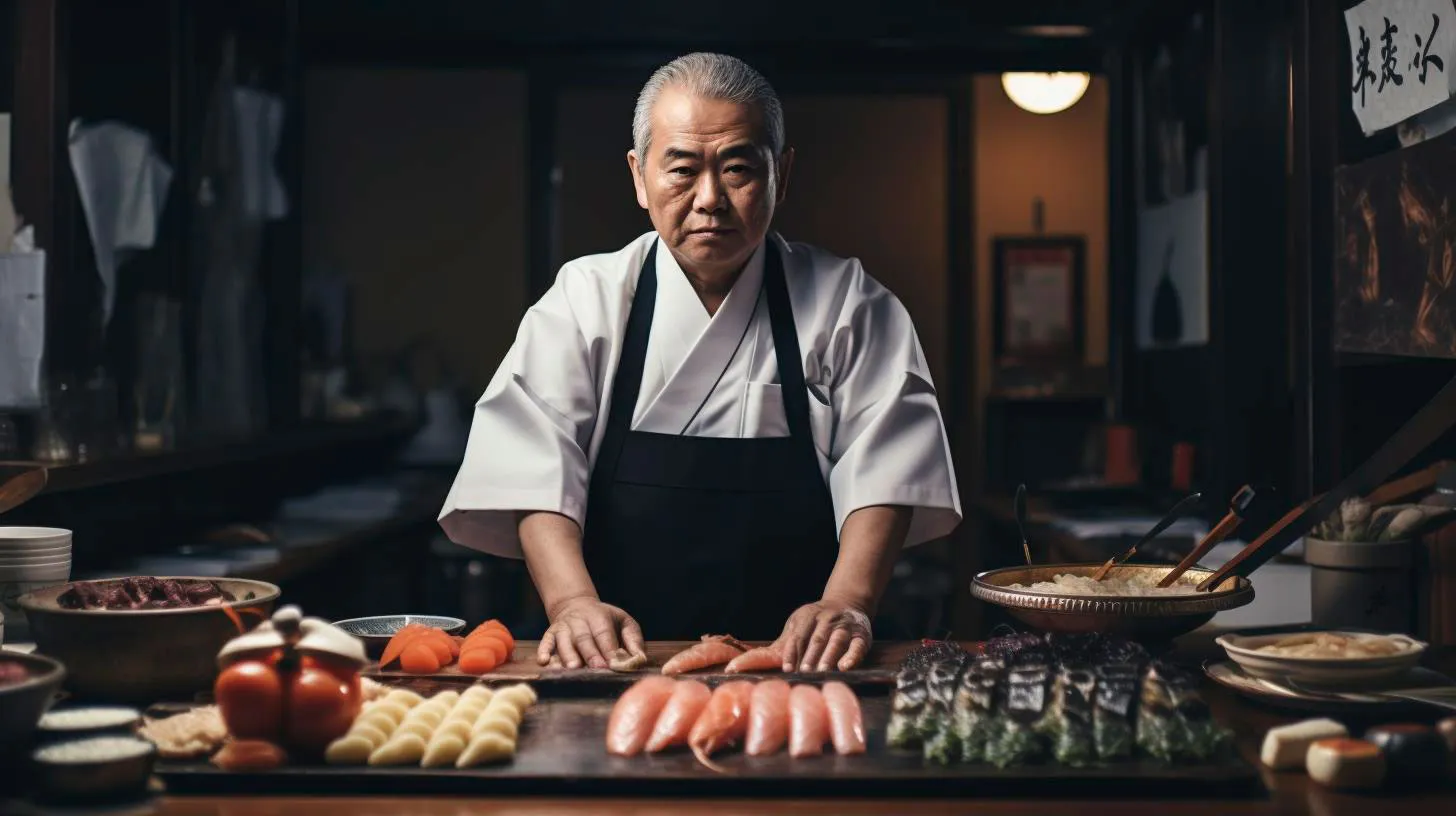Becoming a Sushi Connoisseur: Tips and Techniques for Perfecting Japanese Cuisine
If you are eager to explore the world of sushi and embark on your journey to becoming a sushi connoisseur, we have compiled a comprehensive guide to help you perfect your sushi-making skills. In this article, we will delve into the techniques, ingredients, and tips that will assist you in creating restaurant-quality sushi at home.
Understanding the Basics of Sushi
Before diving into the intricacies of sushi preparation, it is crucial to understand the fundamental aspects of this culinary art form. Here are some key points to remember:
- Sushi is a Japanese dish consisting of vinegared rice combined with various toppings, such as raw or cooked seafood, vegetables, or omelets.
- There are different types of sushi, including nigiri (hand-pressed sushi with a topping), maki (sushi rolls wrapped in seaweed), and sashimi (thinly sliced raw fish or seafood without rice).
- Sushi is commonly dipped in soy sauce and enjoyed with pickled ginger and wasabi.
Mastering Sushi Rice
The foundation of successful sushi lies in mastering the art of sushi rice. Here is a step-by-step guide to achieving the perfect sushi rice:
- Start by choosing the right type of short-grain sushi rice. It is essential for its adherence and stickiness.
- Rinse the rice thoroughly to remove excess starch, which helps prevent the rice from becoming overly sticky.
- Cook the rice following the instructions on the package. Once cooked, allow it to cool slightly.
- In a separate bowl, combine rice vinegar, sugar, and salt. Gently heat this mixture until the sugar and salt dissolve completely.
- Pour the vinegar mixture over the slightly cooled rice and carefully fold it in to evenly distribute the flavors.
Remember that the quality of sushi rice greatly affects the taste and texture of your sushi, so it is worth investing time and effort into perfecting it.
Choosing the Right Ingredients
When it comes to sushi, freshness is key. Here are some tips for choosing the right ingredients:
- Selecting the best-quality fish and seafood is crucial for the taste and safety of your sushi. Look for fish that has been previously frozen, as this eliminates any potential parasites.
- For beginners, it is advisable to start with cooked or smoked ingredients, such as shrimp, crab, or smoked salmon. This reduces the risk of consuming raw fish.
- Don’t forget about vegetarian options! Sushi can be equally delicious with a variety of fresh vegetables, such as cucumber, avocado, or sweet potato.
Perfecting Sushi Rolling Techniques
Creating beautiful sushi rolls requires practice and patience. Here are some key techniques to keep in mind:
- Use a bamboo sushi mat to help shape and roll the sushi neatly.
- Moisten your hands with water or vinegar to prevent the rice from sticking to your fingers.
- Place a sheet of nori (seaweed) on the sushi mat and evenly spread a thin layer of sushi rice over it.
- Add your desired ingredients diagonally across the rice and roll the mat tightly to form a cylinder.
- Apply gentle pressure to ensure the roll holds its shape, then carefully slice it into bite-sized pieces using a sharp knife.
Remember, practice makes perfect. Don’t be discouraged if your first few attempts are not picture-perfect; with time, you will become more skilled at rolling sushi.
Presenting Your Sushi Masterpieces
Just as taste is crucial in Japanese cuisine, presentation plays an equally vital role. Here are some tips to elevate the visual appeal of your sushi creations:
- Arrange your sushi rolls and nigiri on a beautiful plate or wooden board.
- Garnish the plate with freshly grated wasabi, pickled ginger, and a sprinkle of sesame seeds.
- Experiment with different plating styles, such as arranging the sushi in a flower shape or creating colorful patterns with various toppings.
Remember, the presentation should complement the flavors and textures of your sushi.
Key Takeaways
Becoming a sushi connoisseur involves mastering various techniques and principles. Here are the key takeaways from this guide:
- Understand the basics of sushi: its different types, toppings, and traditional accompaniments.
- Pay special attention to sushi rice, as it forms the foundation of any sushi dish.
- Choose the freshest ingredients and explore a variety of options, including both seafood and vegetarian choices.
- Practice sushi rolling techniques to achieve beautiful and well-formed rolls.
- Present your sushi with elegance and creativity, enhancing the overall dining experience.
With dedication, practice, and a dash of creativity, you can master the art of sushi making and impress your friends and family with your delicious creations. So, put on your apron, grab your sushi mat, and embark on an exciting culinary adventure into the world of sushi!
Unlocking the Secrets: Discovering the Path to Sushi Perfection
The Art of Sushi: A Brief Introduction
Sushi originates from Japan and has evolved over centuries into an art form that is celebrated worldwide. In its simplest form, sushi consists of vinegared rice combined with a variety of ingredients such as fish, seafood, or vegetables. The harmonious blend of flavors, textures, and colors reflects the core philosophy of sushi.
Here are some key takeaways to understand and appreciate the art of sushi:
- Umami Explosion: Sushi brings together the five basic tastes, with umami being the most prominent. Umami, the savory taste, enhances the flavor of the ingredients and creates a mouthwatering experience.
- Attention to Detail: Sushi chefs are meticulous in their craft, priding themselves on precision and finesse. Every sushi roll, nigiri, or sashimi plate is a testament to their skills and dedication.
- Seasonality Matters: The use of seasonal ingredients is a fundamental aspect of sushi. It ensures freshness, maximizes flavors, and reflects the natural cycles of the region.
Secrets to Sushi Perfection
1. Quality Ingredients
The foundation of sushi perfection lies in the quality of ingredients used. Fresh fish, sourced from reputable suppliers, is essential for impeccable taste and texture. The finest sushi establishments prioritize sustainable fishing practices.
Key Takeaway: Choose sushi restaurants that emphasize the use of fresh, sustainable ingredients for an extraordinary sushi experience.
2. Proper Rice Preparation
The rice used in sushi plays a crucial role in its overall taste and texture. Short-grain sushi rice is meticulously cooked and seasoned with a delicate balance of vinegar, sugar, and salt. This enhances the flavor profile and gives sushi its characteristic stickiness.
Key Takeaway: Sushi perfection requires precise rice preparation, ensuring the ideal balance of flavors in every bite.
3. Knife Skills and Artistic Presentation
Sushi is not just about taste; it is a visual feast as well. Sushi chefs undergo years of training to master the art of knife skills and presentation. Each ingredient is carefully sliced, shaped, and arranged with utmost precision to create stunning sushi rolls and nigiri.
Key Takeaway: The presentation of sushi is an integral part of the dining experience, heightening both visual and gustatory pleasure.
4. Dipping and Eating Etiquette
A key element of sushi appreciation lies in understanding the proper etiquette when it comes to dipping and eating. Generally, sushi rolls should be enjoyed as-is, while nigiri is lightly dipped, fish-side down, into a small amount of soy sauce. Applying excessive soy sauce can overpower the delicate flavors of sushi.
Key Takeaway: Mastering the art of dipping and eating sushi enhances the overall experience, allowing you to savor the complexity of flavors.
5. Exploring Varieties and Seasonal Delights
Sushi offers an incredible array of flavors, textures, and combinations. From classic nigiri to creative rolls, each sushi type brings its own unique charm. Additionally, exploring seasonal specials allows you to experience sushi at its peak freshness and indulge in the flavors of the moment.
Key Takeaway: Embrace the vast world of sushi by trying different varieties and seasonal delights, expanding your palate and culinary horizons.
The Rise of Sushi: Fascinating Statistics
Sushi’s popularity has soared over the years, transcending cultural boundaries and captivating food enthusiasts worldwide. Here are some fascinating statistics that highlight the rise of sushi:
- According to Statista, the global sushi market is projected to reach a value of $21.56 billion by 2025.
- In the United States alone, sushi consumption has increased by 28% over the last five years, as reported by the USDA.
- Japan has more than 45,000 sushi restaurants, ranging from street stalls to Michelin-starred establishments, showcasing the country’s deep-rooted love for this cuisine.
These statistics reflect the undeniable allure of sushi and the growing demand for this exquisite culinary art form.
In conclusion, sushi is not just a meal; it’s an experience that takes you on a gastronomic adventure. Appreciating the secrets of sushi perfection allows you to unlock the hidden layers of flavors, discover the intricacies of presentation, and embrace the cultural heritage behind this remarkable cuisine. So go ahead and embark on your own sushi journey, savoring each bite while admiring the mastery of sushi craftsmanship.
From Basic Rolls to Culinary Excellence: Mastering the Art of Sushi
In this article, we delve into the basics of sushi-making, explore the techniques used by professional sushi chefs, and provide valuable insights to enhance your sushi experience. So, grab your chopsticks and let’s dive into the world of sushi!
The Essentials: Understanding Sushi
Sushi is not simply raw fish wrapped in rice; it is a delicate harmony of ingredients and exquisite craftsmanship. Here are the key components of sushi:
- Sushi Rice: Also known as shari, sushi rice is a short-grain rice seasoned with a unique blend of vinegar, salt, and sugar. It provides the perfect foundation for sushi rolls.
- Neta (Toppings): Toppings can include various seafood and vegetables such as tuna, salmon, shrimp, cucumber, or avocado. The freshness and quality of the neta significantly impact the overall taste of sushi.
- Nori (Seaweed): Thin sheets of seaweed are used to wrap the sushi rice and neta. Nori adds a subtle saltiness and a satisfying crunch to each bite.
- Wasabi and Soy Sauce: Wasabi, a pungent green paste, and soy sauce, provide an explosion of flavors when combined with sushi. They are often served alongside sushi for dipping purposes.
Now, let’s explore some valuable tips and techniques to take your sushi-making skills to the next level:
Becoming a Sushi Master: Tips and Techniques
1. Freshness is Key
Using fresh, high-quality ingredients is the cornerstone of exceptional sushi. Here’s why:
- Fresh seafood ensures a delicious and safe sushi experience.
- Opt for sustainable seafood options to support the environment.
- Develop a relationship with a trusted fishmonger or supplier for the best-quality ingredients.
2. Mastering the Perfect Sushi Rice
The quality of sushi rice is crucial for achieving sushi perfection. Consider these tips:
- Choose short-grain rice, which has a higher starch content and provides the desired sticky texture.
- Thoroughly rinse the rice to remove excess starch before cooking.
- Use a rice cooker or follow precise stovetop cooking instructions for fluffy and well-seasoned sushi rice.
3. Knife Skills: A Cut Above the Rest
Creating visually appealing sushi rolls requires honed knife skills. Here’s what you need to know:
- Purchase a high-quality, sharp sushi knife with proper maintenance for clean cuts.
- Master various cutting techniques such as hira-zukuri (rectangular slices) or sogi-giri (diagonal slices).
- Practice patience and precision to achieve uniform slices, enhancing the presentation of your sushi.
4. Embrace Creativity: Fusion Sushi
While traditional sushi recipes are delightful, don’t be afraid to venture into the world of fusion sushi. Here are some ideas:
- Experiment with unique combinations of ingredients like spicy tuna, mango, or tempura flakes.
- Incorporate flavors from other cuisines, such as Mexican-inspired sushi with jalapeños or Korean-inspired sushi with kimchi.
- Balance different textures and flavors to create exciting and innovative rolls.
5. Presentation is Everything
The artistry of sushi lies not only in its taste but also in its presentation. Consider these presentation techniques:
- Use fresh and vibrant garnishes like microgreens, edible flowers, or sesame seeds to add visual appeal.
- Arrange sushi rolls elegantly on a plate or sushi board for a visually stunning presentation.
- Pay attention to color combinations and plate composition to create visually harmonious arrangements.
Key Takeaways
Becoming a sushi master takes practice, patience, and an understanding of the fundamentals. Here’s what you should remember:
- Sushi is a delicate harmony of sushi rice, neta, nori, wasabi, and soy sauce.
- Freshness is crucial for exceptional sushi.
- Master the art of sushi rice preparation for the perfect foundation.
- Hone your knife skills to create visually appealing cuts.
- Embrace creativity by trying fusion sushi recipes.
- Pay attention to presentation for a visually stunning sushi experience.
Now that you have a better understanding of the art of sushi-making, it’s time to put your skills to the test. Whether you are hosting a sushi party or simply enjoying sushi at home, remember to savor each bite and embrace the culinary excellence that sushi brings to the table. Happy rolling!
Elevate Your Sushi Skills: A Journey into the World of Japanese Festive Fare
In this article, we will take you on a journey into the world of Japanese festive fare, exploring the secrets behind mastering the art of sushi making.
The Origins of Sushi
Sushi, in its earliest form, dates back to the 2nd century AD. It originated as a way to preserve fish by wrapping it in fermented rice, which was later discarded. Over the centuries, sushi evolved into the refined and elegant culinary delight we know today. Traditional sushi can be traced back to the 19th century, where it gained popularity in Edo (now Tokyo) and Kyoto.
The Key Elements of Sushi
Before diving into the world of sushi making, let’s understand the three fundamental components:
- Sashimi: Thinly sliced, fresh raw fish or seafood
- Shari: Vinegared sushi rice, cooked to perfection
- Neta: Toppings, which include fish, vegetables, and other delights
The Art of Sushi Making
To elevate your sushi skills, it is essential to master the art of sushi making. Here are some key steps to guide you:
- Choose Fresh Ingredients: When it comes to sushi, fresh and high-quality ingredients are crucial. Opt for fresh fish, preferably from a reputable fish market. Additionally, choose seasonal vegetables and other toppings to enhance the flavors.
- Perfect Your Sushi Rice: The rice is the foundation of sushi. Cook the short-grain rice to perfection and season it with a balanced mixture of rice vinegar, sugar, and salt. The rice should be sticky enough to hold the toppings but not overly mushy.
- Master the Techniques: From shaping nigiri (hand-pressed) sushi to rolling maki (sushi rolls), mastering the various sushi-making techniques is the key to creating visually appealing and delicious sushi. Practice makes perfect, so don’t be discouraged if your first attempts are not flawless.
- Experiment with Flavors: While traditional sushi is a delight on its own, don’t be afraid to experiment with different flavors and ingredients. Add a touch of spicy mayo, indulge in unique combinations like fusion-style sushi, or explore vegetarian options for a diverse sushi experience.
The Rise of Sushi in the West
Over the past few decades, sushi has experienced a significant surge in popularity in Western countries. Let’s take a look at some intriguing statistics:
- In the United States alone, sushi consumption has increased by over 400% in the last two decades.
- As of 2020, sushi restaurants in the United Kingdom outnumbered traditional fish and chip shops, a testament to its growing demand.
- Australia, known for its vibrant food scene, has seen a remarkable rise in sushi consumption. It is estimated that Australians consume over 115 million servings of sushi each year.
The Advantages of Making Sushi at Home
While dining out at sushi restaurants is a delightful experience, there are several advantages to making sushi at home:
- Cost-Effective: Sushi can be an expensive dining choice. By making it at home, you can save money while still enjoying the flavors you love.
- Healthier Options: By controlling the ingredients and portion sizes, you can make healthy choices and cater to specific dietary restrictions.
- Bonding Experience: Making sushi at home can be a fun and interactive activity for friends and family, creating lasting memories in the process.
In Summary
Sushi is not only a delicious culinary experience but also a window into Japanese culture. By following the steps outlined above and incorporating your own creativity, you can elevate your sushi skills and embark on a culinary journey like no other. Bring the enticing flavors and artful presentations of sushi into your own kitchen, and enjoy the benefits of creating this Japanese festive fare at home.



